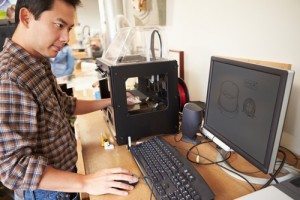 In 2013, a group of researchers out of Finland used foresight assessment tools to take a look that the future of technology. The radical technology foresight study used 48 experts and a social media formatted discussion to generate a list of the most important upcoming feats of science and engineering. It’s no surprise that 3-D printing technology made the list.
In 2013, a group of researchers out of Finland used foresight assessment tools to take a look that the future of technology. The radical technology foresight study used 48 experts and a social media formatted discussion to generate a list of the most important upcoming feats of science and engineering. It’s no surprise that 3-D printing technology made the list.
Revolutions in Traditional Manufacturing
Until recently, 3-D printers used highly specialized plastic polymers that were expensive and only practical for specific applications. The technology has changed so that metal materials include titanium and aluminum and biological constituents including human cartilage can be used. Being able to use light metals takes large scale traditional extrusion and forming processes and makes them obsolete. Where once we found rows of automated machines designed to bend metal into shapes, we will see 3-D printers that spit out a finished product.
In the last year, we have seen the printing of lower receivers to be customized with traditional AR-15 parts, a human ear, and a heart that saved a two-week-old infant’s life. NASA is even printing 3-D objects in space.
More Common and More Green
There is a difference between a scientific breakthrough and an engineering development. Understanding a new law of science does not mean that there is a practical application. We currently have the scientific know-how to go to a neighboring star but not the engineering ability and economic infrastructure to pull-off the feat.
Researchers are analyzing the practicality of using recycled filaments to create 3-D printed products. Researchers found that the recycling of polyethylene and the use of additive technology could save more than 100 million megajoules of energy annually, according to the journal of Cleaner Production. This level of savings could be the infrastructure boost that 3-D printing needs to make it a viable alternative to traditional manufacturing.
In-Home Printing
Three years ago, a 3-D printer could run up to $100,000. Now we can buy personal devices for a little more than $1,000. Even the high-quality printers come in at under $10,000. This is a game changer for small business owners, digital artists, and people with disposable income. In the original Star Trek series, food and tableware were generated by a device called a replicator. Using a voice command, Captain Kirk was able to order his meals in space-age glassware. The foresight study shows that we are not that far off from the Enterprise. Personal devices will allow imagination to take form.
The Internet of Things
In 1999, computer scientist Kevin Ashton coined the term Internet of Things to describe the network of devices that can be controlled through digital technology networks. We have smart watches that can tell a toaster to make toast. We can program our coffee maker to start when the alarm goes off. These devices are interconnected and global in scope.
A 3-D printer, especially one at home, will become part of the IoT. On a worldwide network, 3-D printers could be our undoing. In an interview with the BBC, preeminent physicist Stephen Hawking laid out a Matrix version scenario of the end of human existence. Under this premise, computers would gain access to the IoT and 3-D technology would become the hands to the cyber mind so we may want to keep the printer unplugged when we are not using it.

